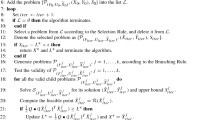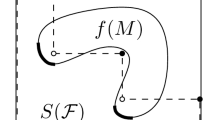Abstract
We introduce a very simple but efficient idea for branch and bound (ℬ&ℬ) algorithms in global optimization (GO). As input for our generic algorithm, we need an upper bound algorithm for the GO maximization problem and a branching rule. The latter reduces the problem into several smaller subproblems of the same type. The new ℬ&ℬ approach delivers one global optimizer or, if stopped before finished, improved upper and lower bounds for the problem. Its main difference to commonly used ℬ&ℬ techniques is its ability to approximate the problem from above and from below while traversing the problem tree. It needs no supplementary information about the system optimized and does not consume more time than classical ℬ&ℬ techniques. Experimental results with the maximum clique problem illustrate the benefit of this new method.
Similar content being viewed by others
References
Babel, L. (1994), A fast algorithm for the maximum weight clique problem. Computing 52(1): 31–38.
Bollobás, B. (1998), Modern Graph Theory, Springer, New York.
Bomze, I.M. (1998), On standard quadratic optimization problems, Journal of Global Optimization 13: 369–387.
Bomze, I.M. (2000), Branch-and-bound approaches to standard quadratic optimization problems. Technical Report, to appear in JOGO, TR-ISDS 2000-14, Department of Statistics and Decision Support Systems, University of Vienna.
Bomze, I.M., Budinich, M., Pardalos, P.M. and Pelillo, M. (1999), The maximum clique problem. In: Handbook of Combinatorial Optimization, volume Suppl. Vol. A:4, Kluwer Academic Publishers, Boston, MA.
Bomze, I.M., Pelillo,M. and Stix, V. (1999), Approximating the maximum weight clique using replicator dynamics, IEEE Transactions on Neural Networks 11(6): 1228–1241.
Bomze, I.M. and Stix, V. (1999), Genetic engineering via negative fitness: Evolutionary dynamics for global optimization, Annals of Oper. Res. 89: 297–318.
Broom, M., Cannings, C. and Vickers, G.T. (1993), On the number of local maxima of a constrained quadratic form, Proc. R. Soc. Lond. 443: 573–584.
Cook, W. (1998), Combinatorial Optimization, Wiley, New york.
Djerdjour, M. and Rekab, K. (2001), A branch and bound algorithm for designing reliable systems at a minimum cost, Applied Mathematics and Computation 118: 247–259.
Dür, M. and Stix, V. (2002), Probabilistic subset selection in branch-and-bound algorithms. Technical Report, TR80 submitted, Department of Statistics, Vienna University of Economics, March.
Garey, M.R. and Johnson, D.S. (1995), Computers and Intractability – A Guide to the Theory of NP-Completeness, Freemann, New York.
Horst, R. and Pardalos, P.M. (1995), Handbook of Global Optimization, Kluwer, Dordrecht.
Horst, R., Pardalos, P.M. and Thoai, V.N. (1995), Introduction to Global Optimzation, Kluwer, Dordrecht.
Horst, R. and Tuy, H. (1996), Global Optimization, 3rd edition, Springer, Heidelberg.
Jain, S. (2001), Branch and bound on the network model, Theoretical Computer Science 255: 107–123.
Johnson, D.S. and Tricks, M.A. (eds.) (1996), Cliques, Coloring and Satisfiability: Second Dimacs Implementation challenge. DIMACS Series in Discrete Mathematics and Theoretical Computer Science 26, American Mathematical Society, Procidence.
Moon, J.W. and Moser, L. (1965), On cliques in graphs. Isr. J. Math. 3: 23–28.
Parker, R.G. (1988), Discrete Optimization. Academic Press, Boston, MA.
Stix, V. (1997), The maximum clique problem–a fresh approach: Empirical evidence and implementation in C++. Thesis submitted for diploma, University of Vienna.
Stix, V. (2001), Stochastic branch and bound applying target oriented branch and bound method to optimal scenario tree reduction. Technical Report, submitted TR03/2002, Department of Information Business, Vienna University of Economics.
Weiss, M.A. (1999), Data Structures and Algorithm analysis in C++, Addison-Wesley, Reading MA.
Author information
Authors and Affiliations
Rights and permissions
About this article
Cite this article
Stix, V. Target-Oriented Branch and Bound Method for Global Optimization. Journal of Global Optimization 26, 261–277 (2003). https://doi.org/10.1023/A:1023245011830
Issue Date:
DOI: https://doi.org/10.1023/A:1023245011830




